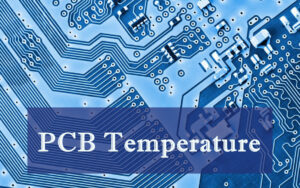PCB Temperature Guide
2022-10-11PCB temperature is an important indicator of safety, reliability and performance. Excessive temperatures are likely to cause failures and permanent damage.
During the PCB manufacturing process, there are several conditions that can generate more heat. For example, external component mounting, drilling and soldering processes, inadequate environmental ventilation and other factors can generate excessive heat, which can lead to damage to the board.
In either case, effective PCB cooling techniques and PCB thermal management can significantly control excessive PCB temperatures. In this article we will explain in detail there are issues related to PCB temperature.
How to measure the PCB temperature?
Before measuring the PCB temperature, you first need to determine the main heat source in the PCB, usually a microcontroller or processor, or locate the temperature sensor.
Next, find the connection to the ground (GND) pins of the heat source substrate. most of the heat generated in the PCB is transmitted to the temperature sensor through these pins.
Then we can start measuring the PCB temperature, which usually involves the following three steps.
- Place a grounding layer between the temperature sensor and the heat source
- Connect the GND pin of each temperature sensing to the ground layer of the heat source
- Ensure that the temperature sensor and the heat source on the PCB remain close to each other
Common causes of high PCB temperatures
How much heat a PCB can withstand depends on the materials used to make it up. Materials with the best thermal properties can effectively resist the effects of temperature. In the selection of materials for PCB, you can choose a high TG material.
Some common causes of high PCB temperatures are.
- Component failure.
- Through-hole interference.
- Surface mount component distance.
- High frequency circuits. 5.
- Lead-free solder.
Why is it important to measure PCB temperature?
It is important to monitor the PCB temperature, too high a temperature can led to structural changes in the performance of the PCB, or even damage.
Overheating in the PCB can lead to damage to the following.
- Structural integrity
- Circuit interruption
- Different material expansion rates
- Oxidation
How to prevent excessive PCB temperature?
To prevent the PCB from heating up, engineers can take the following PCB cooling techniques.
Use heat sink
Heat sink can effectively and safely dissipate heat.
Use a cooling fan
Cooling fan allows the temperature to dissipate while allowing cold air to enter, helping to prevent the PCB from overheating.
Select heat-resistant materials
Compared to standard PCBs, thick copper PCBs have excellent resistance to high temperatures and can handle higher levels of current and provide stronger connection points.
Increase the board thickness and width
In PCBs, thicker boards tend to be less efficient than thinner boards in terms of thermal conductivity, which means that more power is required to enable thicker boards to reach high temperatures, which can effectively avoid PCB overheating.
Application laminate
High-temperature PCB laminates can prevent overheating by providing thermal protection for PCB components.
Use similar coefficient of thermal expansion materials
The coefficient of thermal expansion (CTE) measures how much a material expands when exposed to high temperatures. In a PCB design, the ideal dielectric layer has a similar CTE to the copper layer. this way, if the layers expand, they will expand in a uniform manner, thus minimizing damage.
Maintain adequate spacing
When circuit board components are too close together, it may lead to crosstalk and increased alignment resistance, resulting in resistance loss and increased circuit heat.
Integrate heat pipes
The liquid in the PCB heat pipe piping absorbs heat and prevents it from damaging the board components.
Contact KingPCB
When you are looking for a PCB that can be specifically designed for temperature control, KingPCB is your trusted partner with extensive manufacturing and assembly experience to help you evaluate your project, and a professional team to help you manufacture your PCB efficiently.
Contact us today for a quote or for more information.




